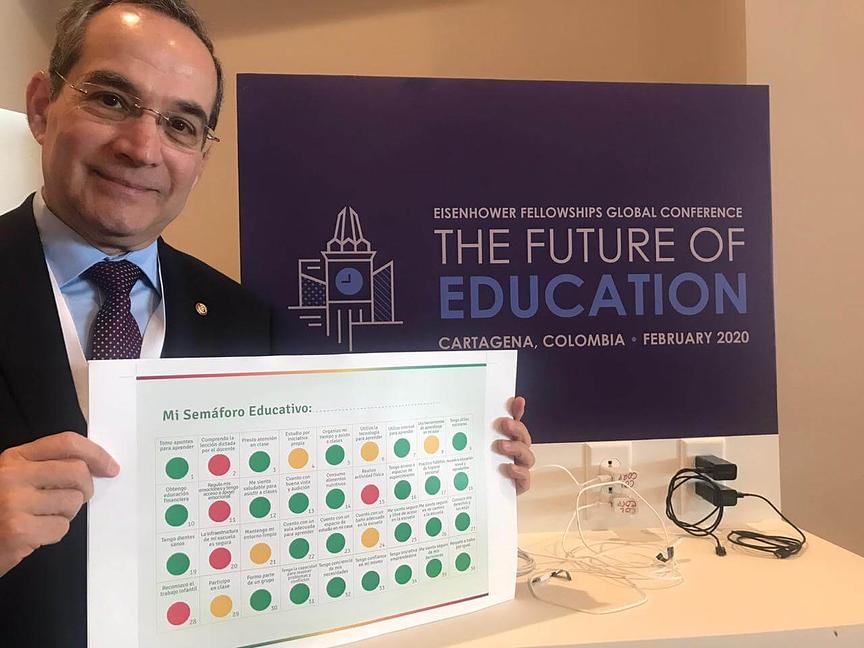WHAT IS THE EDUCATION STOPLIGHT?
The Education Stoplight consists of three self-assessment surveys: one for students, one for parents/guardians, and one for teachers. The Stoplight allows them to evaluate their educational context, identifying their gaps and strengths. At the same time, it serves as a starting point for the design of informed strategies that will drive each one to achieve educational success.
Each survey is divided into dimensions and indicators that measure education conditions in three levels:
- Green representing a situation of success.
- Yellow representing a situation in progress.
- Red representing a situation to be improved.
The Education Stoplight considers students as protagonists of the education process. It allows them to self-assess factors associated with their education and implement a personalized plan to achieve their learning achievements. Through the Stoplight, students are encouraged to critically evaluate their learning, identify gaps in their education process, discern strategies to reach their goal, learn independently and apply critical thinking for their own success.
In its student version, the Stoplight proposes six dimensions:
- Learning practices
- Educational tools
- Health and Well-being
- Resources and environment
- Safety and Security
- Interiority, motivation and participation
For parents and guardians, the Education Stoplight allows them to self-assess the socio-emotional conditions that affect their children's education in order to identify concrete actions to better support them. Through this evaluation, parents and/or guardians will be able to decipher tactics to reach their goals focused on the participation and care of their children's student life.
In its parent/guardian version, the Stoplight proposes four dimensions:
- Health and Well-being
- Commitment and Communication
- Learning conditions
- Discipline and Affection
For teachers, it allows them to self-evaluate their teaching-learning process to achieve their teaching goals. By using the Stoplight as a means of evaluation, teachers will have the benefit of specifically visualizing their strengths, as well as the areas of improvement necessary to develop an optimal educational context.
For its teacher version, the Stoplight proposes four dimensions:
- Health and Well-being
- Teaching practices
- Ethics and Continuous Learning
- Resources and Environment
HOW DOES IT WORK?
The Stoplight works hand-in-hand with education institutions to address the short-comings in education. This framework aims for all participants (students, parents/guardians, and teachers) to go through these four steps:
- Self-evaluation of educational conditions, where participants can identify their strengths and challenges.
- Create an Educational Success Map, where participants use their own data to select the indicators they wish to address first.
- Designing strategies and implementing solutions, where participants work to improve their selected indicators.
- Monitoring progress, where participants can retake the self-assessment to see their progress over time.
EDUCATION STOPLIGHT TECHNOLOGY
The Education Stoplight uses technology to optimize the process of data collection, allowing for an easy analysis of the results. In this way, participants can closely monitor their progress and intuitively visualize their education success plan, whereas institution can use aggregated data to understand common challenges in specific indicators, and design interventions that will enable participants to improve their educational condition.
PROSPERITY IN EDUCATION FRAMEWORK
Developed by Dr. J. Douglas Willms, this framwork aims to provide all children with the opportunity to achieve success by monitoring the success of teachers, families, communities and public institutions in developing the academic, physical, social, emotional and spiritual well-being of children.
The Prosperity in Education framework is based primarily on two premises: 1) success is cumulative (starting in the prenatal stage and continuing through upper secondary) and non-linear (not based on a cause-and-effect framework); and 2) in addition, it seeks to provide a multidimensional understanding of development at each stage of children's lives, looking at the role of families, institutions and communities. In this way, it recognizes that school resources and factors alone are not the only basis for academic achievement.
The Education Stoplight takes these principles, along with an extensive review of the literature, to construct indicators that are actionable, understandable and measurable for each agent (student, parent/guardian, and teacher). Thus, the Stoplight is an evaluation that not only supports the definition of public policies, but also empowers the main agents so they can take action on the issues that affect them.



